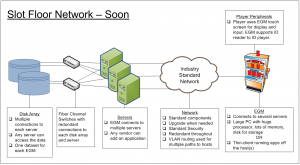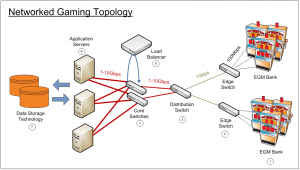Connecting the Dots – Part III
Networking your gaming floor: The bits and pieces
by Russ Ristine
Note: This article originally appeared in the November 1, 2009 issue of Slot Manager magazine.Casino slot managers today can look forward to myriad opportunities and benefits as they begin to move toward a server-based future.
Current technology
Many existing slot floor networks were designed 20 years ago. Though minor improvements were introduced when player tracking (1985), bonusing (1990), and ticket in/ticket out (2000) were added to the networks, each improvement was just an evolution of the proprietary network designed by each slot system manufacturer.
Although these networks are adequate for the traffic they carry, their proprietary nature excludes third-party applications from interacting directly with your electronic gaming machines (EGMs), or even accessing the data stored in your system, without the slot system manufacturer’s permission. The result is a very secure single-purpose environment that cannot be leveraged easily for third-party innovations. As many have experienced, only your slot system provider can support you when you have performance challenges, need a new feature or application, or have communication issues with EGMs or other systems.
Soon technology
Unlike proprietary networks, G2S requires an entirely new network methodology in which each EGM communicates securely with multiple servers. Since G2S uses an open communication protocol designed by the gaming industry, anyone that implements the protocol will be able to offer solutions for your gaming floor.
G2S messages will be transported using standard Internet technologies over a network that you own, which can be designed by network engineering experts (the same folks who design cost-effective, highly secure, stable, high-performance networks for banks, universities and other businesses with complex data needs). You’ll be able to use state-of-the-art server technologies that take advantage of shared data storage systems, resulting in a slot floor system that is powerful, scalable and can shrug off component failures. In short, you’ll end up with a highly available slot floor network in which anyone can participate with your permission – adding applications, helping with performance issues, or even resolving communication issues between devices.
Examining the pieces
To get a better understanding of this new environment, let’s take a look at each of the physical components and then the technologies from EGM to server:
- EGM – Rather than communicating directly to a SMIB using a polled protocol (SAS at 0.019 Mbps [million bits of data per second or “megabit”]) over a serial connection (remember RS-232?), in this new environment your EGMs will communicate with multiple servers over Ethernet (100 Megabit – more than 5,000 times faster than the current connection!). The demands of this new environment will mean that EGMs will soon be as powerful as the best home gaming computers you can buy (incredible graphics, lots of memory, superfast processors, and maybe even high-speed disk drives for persistent storage). The EGM connects to an Edge Switch (the end-point in your new network), which is located in the slot bank or carousel.
- Edge Switch – Inside each bank of machines will be an intelligent Edge Switch. Because it is managed remotely (from your data center), none of the empty ports works without permission from a central authority (so hacker boy can’t plug in his laptop, even if he could get access to the switch).When an EGM is connected to one of the ports, a request is sent to the central authorizing system to make sure it is allowed on the network, and to determine which servers it will connect to (a virtual route, or VLAN, is determined to identify the route that messages from this EGM will take through the network to get to the servers it needs to connect with). From this point on, this EGM will be permitted to use this port on this router.
Since each EGM talks to a single Edge Switch, Edge Switches must be accessible so slot network technicians can easily swap out switches in the event of a bank-wide communication failure. From the Edge Switch, the network will typically continue to the Distribution Switch in the wiring closet – still using copper wire for easier maintenance (as long as the distance from the bank to the wiring closet is less than 300 feet). The traffic from up to 24 individual EGMs will now travel over this single route to and from the bank to the distribution closet, so the speeds here should increase from a 100-Megabit to a 1000-Megabit connection (also referred to as Gigabit Ethernet).
- Distribution Switch – Now we’re into somewhat larger pieces of network gear. Multiple Edge Switches all converge at a network distribution closet, typically located just off the casino floor. The main function of the Distribution Switch is to convert all of this floor traffic to a fiber backbone, with speeds of 1 to 10 Gigabits per second (Gbps). Since the connection between the closet and the data center is pretty stable, fiber optic cabling is used, increasing the length of this segment to over 500 meters. Though hot spares are often used to accommodate a failing Distribution Switch, an installation will typically have redundant connections from each Distribution Switch to the Core Switches (the big head-end switches in the data center).
- Core Switches – These are the large switches at the head-end of the network (just before the servers). The network traffic from multiple Distribution Switches gets routed through each of the Core Servers, and is then routed to one or more application servers. Speeds here are often 10 Gbps – if your Core Switches are less than this, make sure they can be field upgraded in the future to ensure that they don’t have to be replaced in the next few years as more and more cool new features are added to your gaming floor.
- Load Balancers – To ensure that all of your components are pulling their weight, you can employ network and server load balancers to spread network traffic across all of the possible routes to your application servers. At the application servers, the EGM load can be distributed across multiple servers, as long as there is a shared data storage solution in place to ensure that the data for an EGM is still available if a server goes away and another server has to take its place. It is also important to remember that load balancing assignments should be “sticky” (if EGM “RBG_1234” is routed to server 1 at start-up, it should always go to that server unless the connection is ended), so an EGM’s messages always end up at a server who knows who he is (thereby minimizing disruption).
- Application Servers – The best news is that your EGMs can now talk to multiple servers from different vendors. This means that when an EGM manufacturer comes out with a new game, with a new feature that requires some interaction from a server, they can also distribute an application server in support of that feature. Since any server can subscribe to the accounting meters (and events) that it needs, your tried and true accounting system doesn’t have to be disrupted when this new application server is added to the mix – it can still get the meters that it needs.
- Data Storage Technology – Fiber Channel switches offer high-speed (and redundant) connections from the servers to the data storage system. Rather than a single set of disks per server, all servers can now access the same data storage system, making the failure of a single server essentially unnoticeable to the casino.
Concluding thoughts
In the last 10 years, the world has moved from 10-megabit Ethernet as the standard connection to devices to gigabit links as the standard. As you are now looking at an investment in your casino floor networking infrastructure that will last for seven to 10 years, you will want to ensure that your network equipment can support even higher speeds in the future. EGM connectivity and speeds haven’t increased as rapidly as Ethernet, but with the advent of G2S connections and IP-based gaming, the need for 100-Megabit connections for EGMs will be the minimum for the coming years. Since EGMs employing multiplayer technologies and streaming media solutions may employ even faster network interfaces, Edge Switches that are Gigabit capable, and the capability of upgrading the core segments of the network to 10-Gigabit are recommended practices. The slot floor network will soon become part of your enterprise-wide solution – make sure that you’re ready for that future, and for what comes about in the five years after it is first deployed.



